I have long had a soft spot for the Eco-Tourer. If you have not seen it before, where have you been? It has been on the market since 2003 and, hand on my heart, it remains one of the most unique creations within the Australian RV industry.
Of all the caravans and campers with a wind-up roof, the Eco-Tourer is also among the easiest to set-up. In fact, it’s arguably quicker and easier to set-up than a conventional pop-top.
There are numerous models variants and layout options available, offering cafe or club dinettes, single beds or double beds, and even a couple of layouts with a combo shower and toilet.
To me, the Eco-Tourer is testament to what can be achieved in a relatively confined space. When its manufacturer employs ingenuity, along with a dose of lateral thinking, an RV does not have to be 24ft-plus to offer the same features.
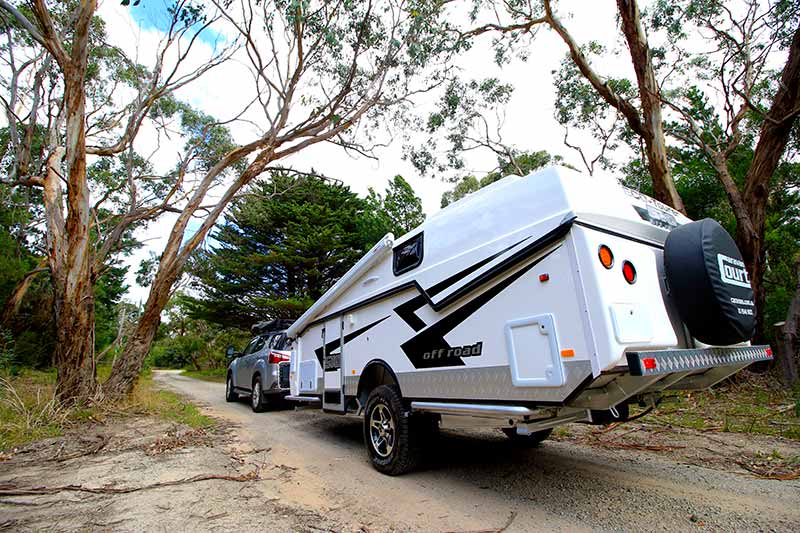 The Eco-Tourer is the property of Caravan Court, a caravan dealership (with adjoining caravan park) in Springvale, Vic. It has long been built in China, strictly to Australian specifications. It has been refined over the years, and it is worth emphasising that the Eco-Tourer is a high quality product.
The Eco-Tourer is the property of Caravan Court, a caravan dealership (with adjoining caravan park) in Springvale, Vic. It has long been built in China, strictly to Australian specifications. It has been refined over the years, and it is worth emphasising that the Eco-Tourer is a high quality product.
It had been quite a few years since I’d last hitched one up, so when the opportunity to review the 510 offroad model came about, I could not wait…
SETTING UP THE ECO-TOURER
All Eco-Tourers are erected in the same way. Unlike a pop-top, it only has two over-centre clasps – simply undo them and insert the winder into the nearside winding point.
Hint: use a portable drill to jack up the roof. The roof will be raised in, literally, five seconds. The unique jacking mechanism, which is concealed behind the van’s spacious front boot, is especially smooth.
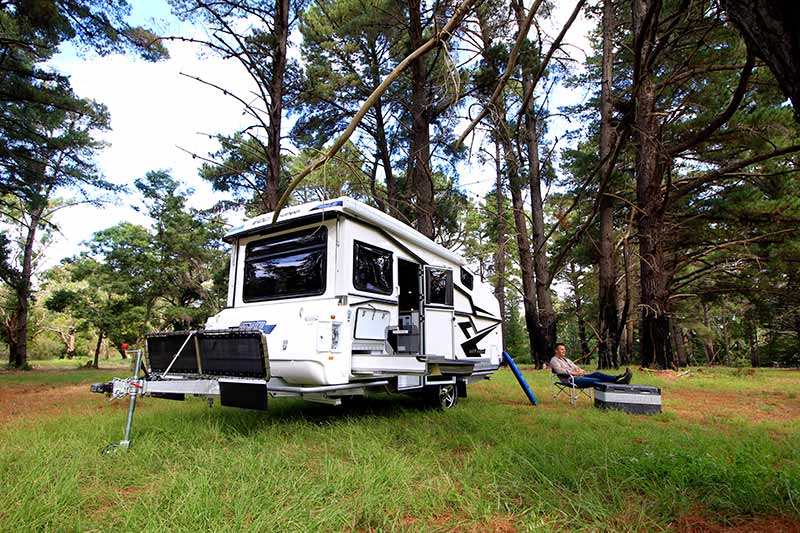 As the roof lifts, the side walls automatically lift and lock into position – no manual effort is required here. The door is the same story – unlike many wind-up camper trailers, it is not necessary to separately secure the top half of the door.
As the roof lifts, the side walls automatically lift and lock into position – no manual effort is required here. The door is the same story – unlike many wind-up camper trailers, it is not necessary to separately secure the top half of the door.
Once the roof is up, it is just a matter of stepping inside and lifting the front wall, locking it into place, and then fitting an upper flap. The result is almost seamless.
Again, to compare it to a pop-top… well, there is no comparison. For older people, or people with back problems, lifting the roof of a pop-top can be a tall order, especially if that roof has an air-conditioner. In terms of setting up, the Eco-Tourer wins hands down.
It’s essential, however, to be very mindful when packing up. This means making sure both the shower door and entry door are closed, and that the front wall has been lowered. During my review, I made a rookie mistake: a squall came through and, quickly packing up, I left the entry door open. The roof slightly crushed the door’s upper trim which, I was relieved to discover, was a cheap and easy fix for the team back at Caravan Court.
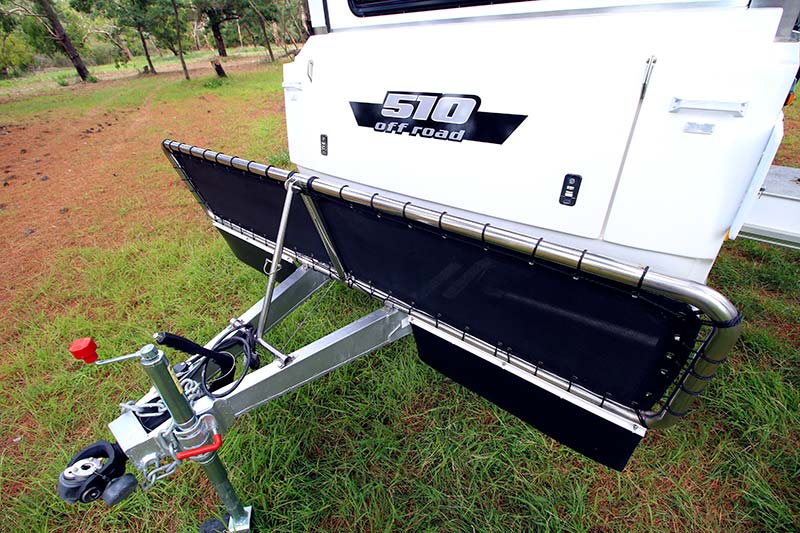 In part, the Eco-Tourer has built its appeal on its light weight and relatively small size. With a travel height of 2.06m for the entry-level Breeze and mid-spec Slipstream models and 2.22m for the top-end Hurricane offroad model reviewed here, the Eco-Tourer offers much less wind resistance under tow, making it a more fuel-efficient proposition than full-height caravans or pop-tops.
In part, the Eco-Tourer has built its appeal on its light weight and relatively small size. With a travel height of 2.06m for the entry-level Breeze and mid-spec Slipstream models and 2.22m for the top-end Hurricane offroad model reviewed here, the Eco-Tourer offers much less wind resistance under tow, making it a more fuel-efficient proposition than full-height caravans or pop-tops.
Further, a patented folding drawbar system is standard equipment on all Eco-Tourers. Just fit a secondary jockey wheel, wind out a couple of heavy-duty outer nuts, and lift the drawbar to vertical. This allows the Eco-Tourer to fit in most standard home garages. Absolutely brilliant – and very well engineered.
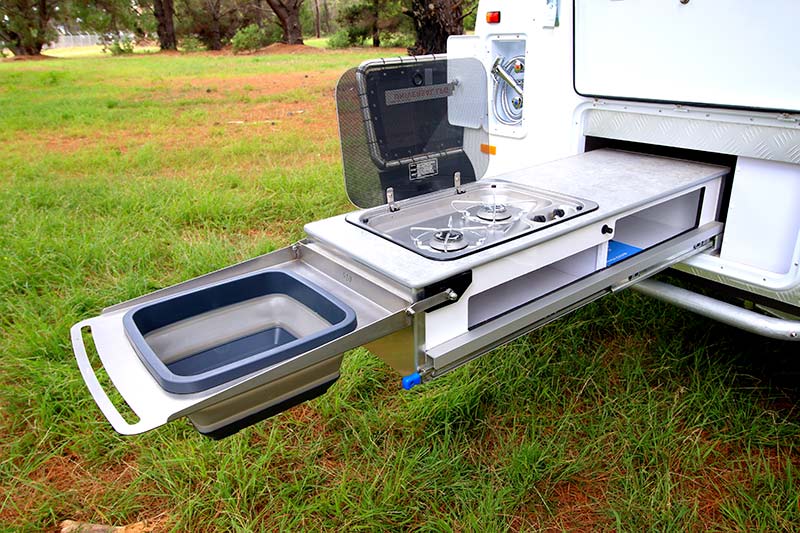 Among the other external features, I liked the optional slide-out kitchen, which is built by the Eco-Tourer team. It contains a two burner gas cooktop and a stainless steel ‘fold-out’ section for a removable sink. The sink is one of those space-saving, collapsible silicone products. No taps or water lines are provided at the sink for one logical reason: a hot/cold external shower is right next to the kitchen, so you simply use that to fill the sink instead.
Among the other external features, I liked the optional slide-out kitchen, which is built by the Eco-Tourer team. It contains a two burner gas cooktop and a stainless steel ‘fold-out’ section for a removable sink. The sink is one of those space-saving, collapsible silicone products. No taps or water lines are provided at the sink for one logical reason: a hot/cold external shower is right next to the kitchen, so you simply use that to fill the sink instead.
The Eco-Tourer’s hot-dipped-galvanised chassis features double hollow section beams in high-stress areas, along with tapered sections where necessary. The walls, meanwhile, are a polyurethane sandwich panel with fibreglass skin either side. The construction appears to be very robust and, without question, it is highly refined.
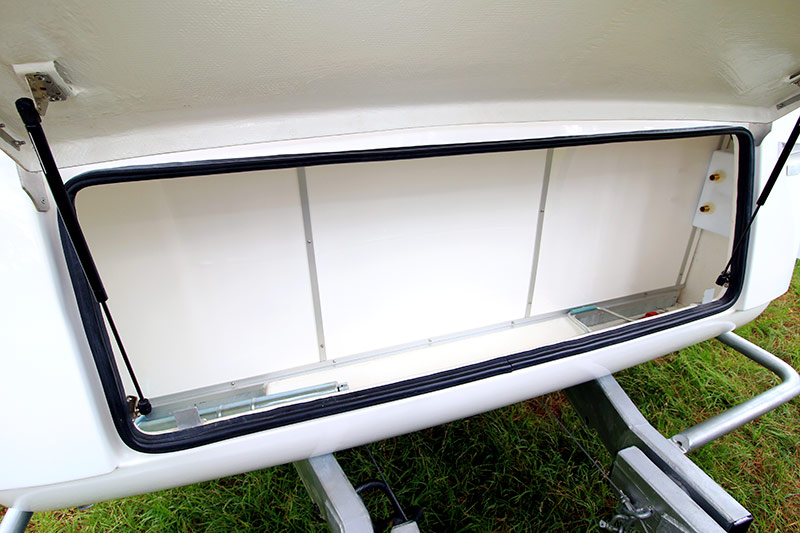 The fibreglass skin found on the Eco-Tourer provides an excellent mounting point, too, for the internal furniture.
The fibreglass skin found on the Eco-Tourer provides an excellent mounting point, too, for the internal furniture.
The roof is a one-piece fibreglass panel with seven structural internal beams, which also form the overhead cupboards. The remaining areas are filled with 50mm bonded polystyrene, and finished with vinyl-coated plywood ceiling panels.
INSIDE THE ECO-TOURER
Our 510 offroad Eco-Tourer sported the ‘Club Shower’ layout. This incorporates a club lounge in the nose of the van, a small offside kitchen with a three-burner cooktop and sink, a bed in the rear offside corner and a combo shower/toilet tucked into the rear nearside corner.
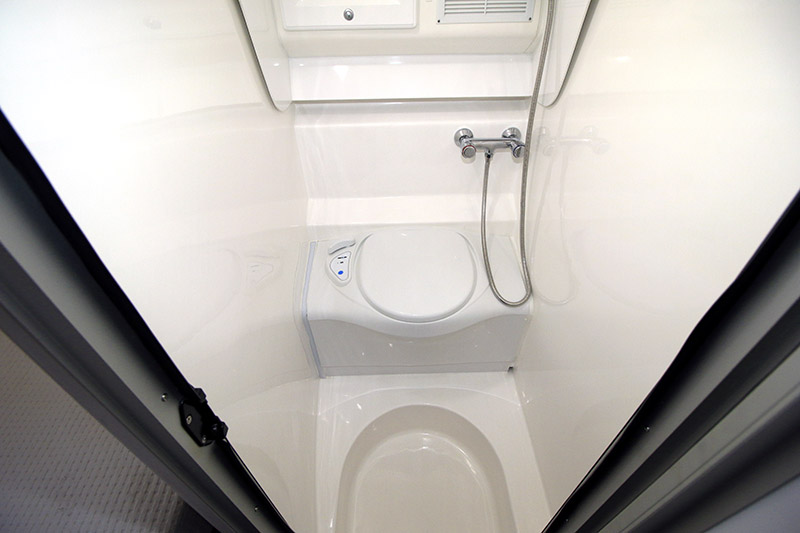 Of all the interesting features, a few stood out to me. Let’s start with the combo bathroom. It is all moulded fibreglass, with a built-in cassette toilet and hand-held shower rose. To gain the necessary head height, the shower base has been recessed somewhat, with checkerplate fitted to the underside for protection, since it hangs a little lower than the rest of the floor.
Of all the interesting features, a few stood out to me. Let’s start with the combo bathroom. It is all moulded fibreglass, with a built-in cassette toilet and hand-held shower rose. To gain the necessary head height, the shower base has been recessed somewhat, with checkerplate fitted to the underside for protection, since it hangs a little lower than the rest of the floor.
There is also a small vanity unit outside the bathroom, on the nearside, with a small sink and tap, and some storage cupboards.
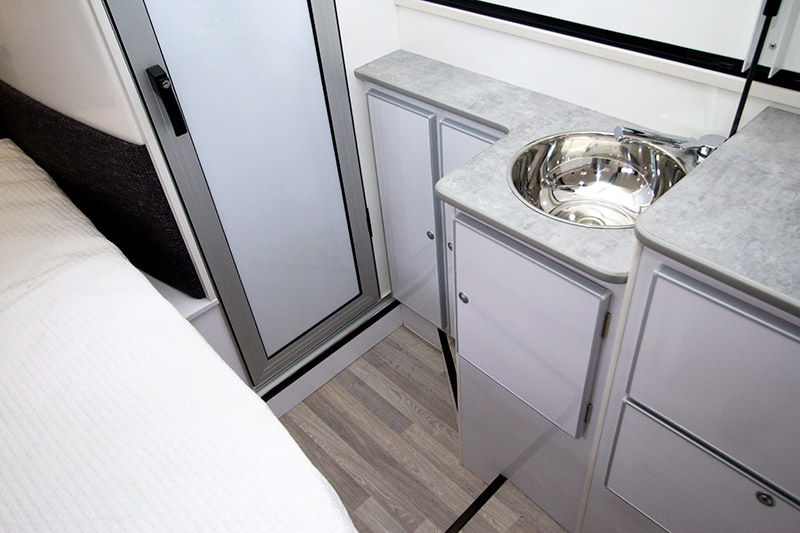 Our review van was fitted with a number of options, from the aforementioned slide-out kitchen and external shower to the adjustable table in the club lounge, a Sirocco fan, a 120Ah lithium battery, a 12V compressor under-bench fridge, a reverse-cycle air-conditioner under the bed, and even a grey water tank.
Our review van was fitted with a number of options, from the aforementioned slide-out kitchen and external shower to the adjustable table in the club lounge, a Sirocco fan, a 120Ah lithium battery, a 12V compressor under-bench fridge, a reverse-cycle air-conditioner under the bed, and even a grey water tank.
The lithium battery is kept charged by two 145W roof-mounted solar panels, with the 12V system managed by the onboard Redarc Manager 30 battery management system.
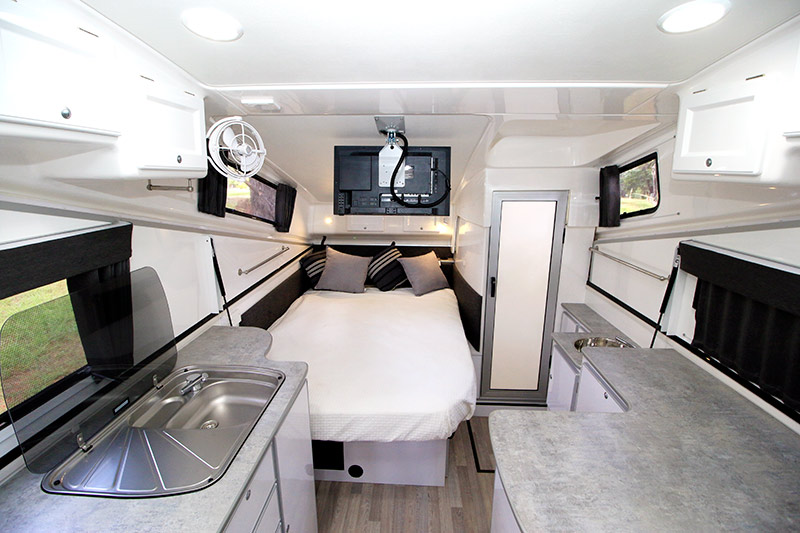 At the foot of the bed, a TV hangs from the ceiling on a special bracket that allows it to be swivelled 180 degrees to be viewed from either the dinette or the bed. Nice.
At the foot of the bed, a TV hangs from the ceiling on a special bracket that allows it to be swivelled 180 degrees to be viewed from either the dinette or the bed. Nice.
Due to its size, there are a number of expected compromises found throughout the Eco-Tourer. The internal kitchen bench is small, for example. You’ll no doubt find yourself preparing meals on the dinette table, so the external slide-out kitchen is almost a must, in my opinion.
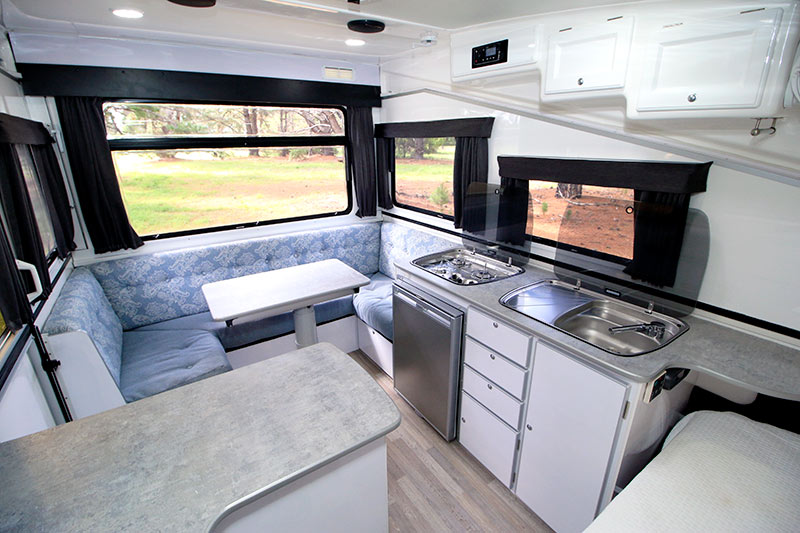 Having said that, the trade-off – a compact, clever, well-finished and well-engineered unit – is more than worth it.
Having said that, the trade-off – a compact, clever, well-finished and well-engineered unit – is more than worth it.
GORV’S VERDICT
Weighing 1930kg Tare, the Eco-Tourer is reasonably light and, fully loaded, it is well within the capabilities of the Prado, Pajero and a host of other tow vehicles. Obviously, the Tare will depend on options, etc., so other Eco-Tourers may well be lighter.
My MU-X towed it as though it wasn’t there – the Eco-Tourer was stable at all speeds and on all terrains, from the open highway to gravel secondary roads, and on all of the offroad undulations that we could find.
Its fundamental design is much the same as it was in 2003, but the Eco-Tourer is as relevant today as a couple’s van as it was back then.
THE SCORE
FIT AND FINISH – 
LAYOUT – 
INNOVATION – 
HITS & MISSES
COMPLETE SPECS
Overall length: 5.7m (drawbar folded up)
External body length: 5.1m
External width: 2.3m
Internal height: 2m (at highest point)
Travel height: 2.2m
Tare: 1930kg
GTM: 2400kg
ATM: 2450kg
Unladen ball weight: 190kg
Group axle capacity: 2600kg
Cladding: Composite fibreglass
Frame: NA
Coupling: DO35
Chassis: Hot-dipped-galvanised
Suspension: 2600kg-rated Cruisemaster XT
Brakes: 12in electric
Wheels: 16in alloy
Fresh water: 2x82L
Grey water: 1x110L
Awning: Fiamma wind-out
Battery: 1x120Ah lithium with Redarc Manager 30 BMS
Solar: 2x145W
Air-conditioner: Under-bed, reverse-cycle
Gas: 2x4kg
Sway control: No
Cooking: Internal three-burner cooktop
Refrigeration: 108L CRX110 compressor
Microwave: Yes
Toilet: Cassette
Shower: Variable height
Washing machine: No
Lighting: 12V LED
Hot water: Gas/electric
Slide-out kitchen with two-burner cooktop
Grey water tank
Air-conditioner
Adjustable dinette table
External shower
Sirocco fan
CRX110 fridge
$84,440
Base price: $77,000





